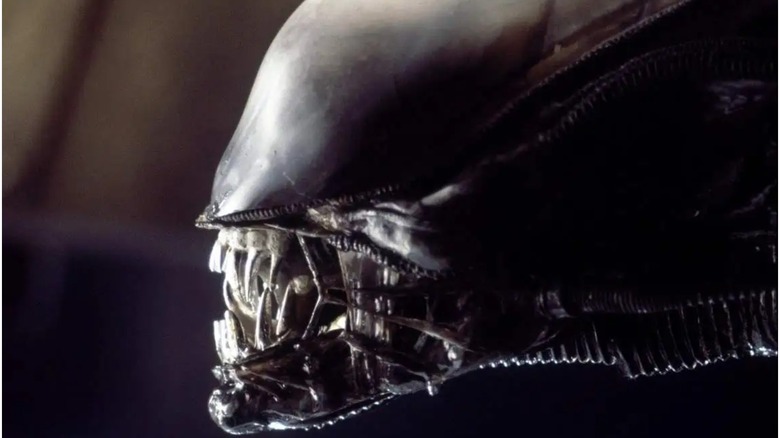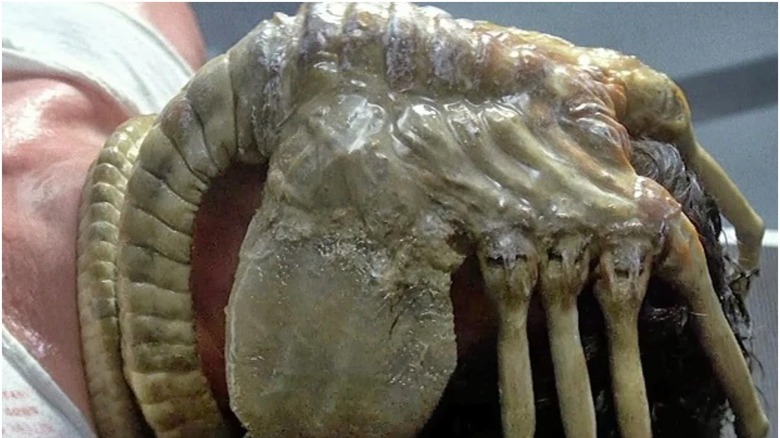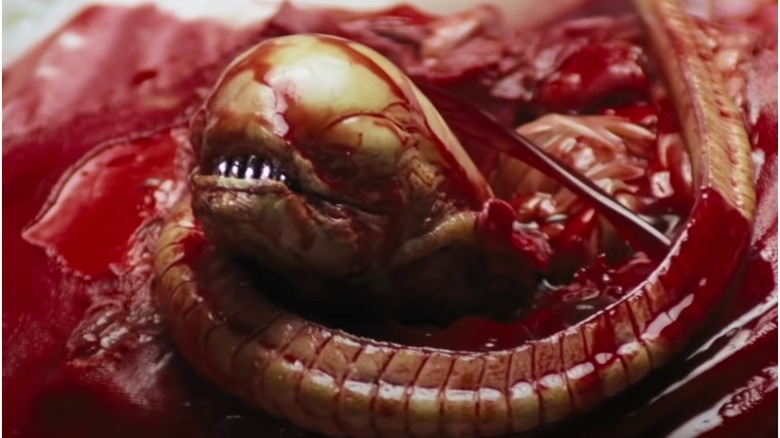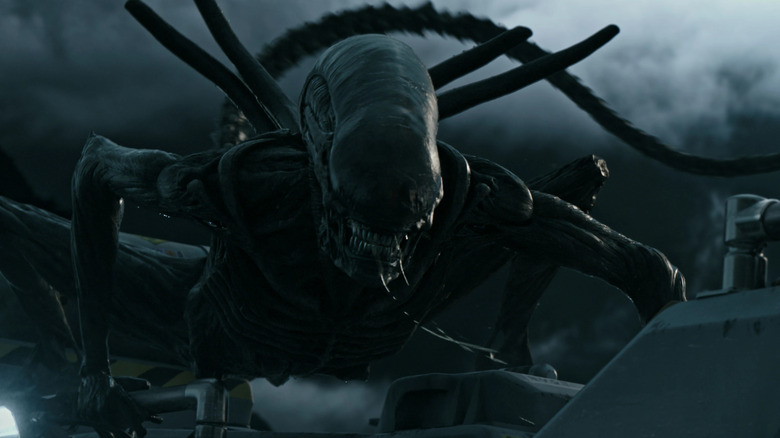What Alien's Xenomorph Originally Looked Like
Whatever you prefer to call it — the Alien, the Xenomorph, or the Chestburster — the monster of Ridley Scott's "Alien" is, at the bare minimum, one of the top five most iconic movie monsters. The creature has appeared in many films since "Alien," but the original was played by Bolaji Badejo; everything about the actor, besides his imposing 6'10 frame, was concealed beneath a costume.
The design of this costume was the work of H.R. Giger. The artist knocked it out of the park, both in creating a monster that reflected the unique terrors of the film and which endured in the public consciousness afterward. The alien's design is, well, alien — but also strikingly humanoid. It walks on two legs like a man, and most of its features — from its rod-shaped head to its second mouth to its prehensile tail — are unmistakably phallic. "Alien" is a film about the fear of sexuality and horror of pregnancy, which the monster's design complements. However, before Giger came aboard, other, far less intimidating designs were considered.
An alien that looked real
Screenwriter Dan O'Bannon conceived of "Alien" thanks to his work on John Carpenter's debut feature "Dark Star." Interviewed for the 2003 documentary, "The Beast Within: The Making of Alien," O'Bannon recounts how he came away from that film disappointed with the creature design; take a look and you'll understand why. The "Dark Star" alien was just a beach ball spray painted like a pumpkin with webbed claws at the bottom. In other words, not at all convincing or scary, but all the crew could manage on a $60,000 budget.
O'Bannon's idea for "Alien" was "'Dark Star' as a horror movie instead of a comedy" with "an alien that looked real." However, it took a long design process before Giger would submit his master stroke. As producer Walter Hill recounted to Marc Maron, preliminary director Robert Aldrich suggested shaving a trained Orangutan and using that for the alien. If that's the best Aldrich could come up with, it's a good thing he didn't end up directing the movie.
One of the artists who O'Bannon consulted was Ron Cobb, with whom he'd worked with on "Dark Star." Cobb's Xenomorph was a four-limbed crab-like creature, with the posture of a T-Rex, whisker mandibles, metal hooks at the hands of its arms, and spotted brown/yellow skin. Cobb's more amphibian Xenomorph is an improvement over the "Dark Star" beach ball and Aldrich's shaved Orangutan, but still not as scary as Giger's design. While Cobb's design obviously went unused, one aspect of his design did make it into the film: the alien having acidic blood.
Giger comes aboard
O'Bannon met Giger while the two worked on Alejandro Jodorowsky's unfinished adaptation of "Dune." O'Bannon convinced the final "Alien" director, Ridley Scott, to hire Giger as Production Designer for the film by showing him the artist's painting "Necronom IV," where the genesis of the Xenomorph can be seen. As producer Gordon Carroll recounted in "The Beast Within," "The first second that Ridley saw Giger's work, he knew that the biggest single design problem, maybe the biggest problem in the film, had been solved."
Giger created all four versions of the Alien: the egg, the Facehugger, the Chestburster, and the matured Xenomorph. He also designed the spaceship where the "Nostromo" crew finds the eggs, and the surface of LV-426, the moon where the ship is stranded. What he didn't design was the sets and costumes of the "Nostromo" itself, which were the work of Cobb and Chris Foss. This delineation was intentional so that the film's different settings would look like they were truly of different worlds — and Cobb and Foss' industrial designs and Giger's arcane, bio-mechanical ones are definitely visually distinct.
As Giger recounted in "The Beast Within," he sculpted almost every aspect of the creature except the head, which was instead handled by Carlo Rambaldi. The costume was primarily composed of latex, with the features created via everything from snake spines to Rolls Royce cooling tubes. This mishmash of parts complemented the bio-mechanical nature of the beast.
Xenomorph's design evolution
"Alien" wound up being just the first film in a franchise. New films usually mean new monsters, but redesigning the Xenomorph would mean outdoing perfection. Thus, all later versions of the Xenomorph are just permutations of the original, from the enormous Queen in "Aliens" to the dog-like Runner in "Alien 3," to the albino, smooth-skinned Neomorphs in "Alien Covenant." However, none of these designs were the work of Giger himself.
When directing "Aliens," James Cameron didn't hire Giger back as production designer. He instead recruited Stan Winston, who had designed the T-800's robotic skeleton for Cameron's previous film, "The Terminator." According to J.W. Rinzler's "The Making of Alien," Giger was unhappy about being excluded; that Winston won an Oscar for Best Visual Effects standing on the shoulders of his work likely rubbed salt in the wound.
Giger was still listed as Original Creature Designer in the credits of all the sequels (barring "Alien: Resurrection," at least until he raised hell about it), but it took Scott returning to the series for Giger to as well. In one of Giger's last pre-mortem works before his death in 2014, he supplied concept art for "Prometheus" and earned an Original Design Elements credit.



